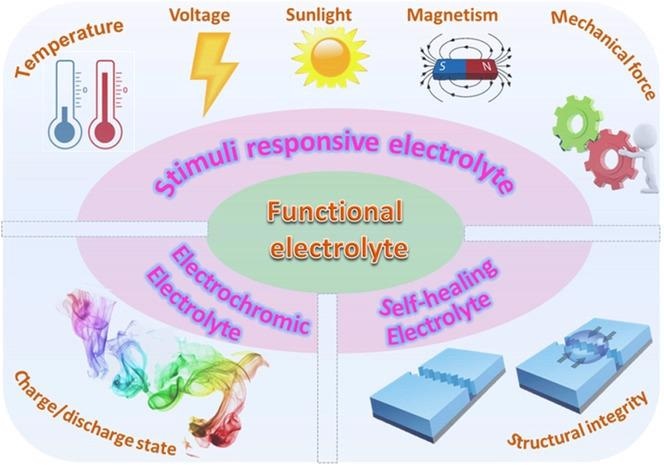Technologies such as artificial intelligence are crucial for human progress in the 21st century. Systems integrating AI will need to have next-generation, smart power solutions. A paper published in 2021 in the journal Wiley Small Science has explored the possibility of creating smart electrochemical energy storage devices by exploiting functional electrolytes.

Schematic of the review content on functional electrolytes. Image Credit: Wang, F., Wiley Small Science
Smart EES Devices: An Overview
The coming industrial revolution is likely to be a game-changer for technological progress. Recent developments in the field of artificial intelligence are making inroads into multiple industries via the laboratory. Growth in the smart electronics market has led to strong demand for the development of new, efficient power sources.
Portable electronic products have seen the widespread use of electrochemical storage (EES) devices. Rechargeable batteries have been used as power sources in applications that require large energy density. High power-output supercapacitors are in common use, that exhibit energy storage capacities comparable to rechargeable batteries.
Future smart electronics require more than just superior levels of energy storage, though: they also require EES devices that can monitor internal parameters in real-time and regulate and adjust their internal energy storage. Internal parameters include temperature, mechanical properties, and voltage. Power sources also need to be reliable. This is not possible with current EES technologies.
The key to addressing these challenges is including smart elements in EES devices. These elements will give devices the ability to self-heal, self-charge, self-protect, and monitor themselves and the system they are installed in real-time. Multiple studies have made a considerable effort to explore the possibilities of designing truly smart, versatile EES devices.
Why Using Functional Electrolytes Will Help Achieve This
Functional electrolytes, electrodes, and functional current collectors are a particular focus of research currently due to their intrinsic properties. The most common approach is integrating functional electrolytes into smart EES systems due to their central positioning, which gives them access to all the components in the device.
Functional electrolytes exhibit highly sensitive responses to external and internal stimuli. Their capabilities include electrolyte leakage prevention, self-power, improvements in performance, and self-healing. These capabilities make them ideal for smart applications.
Functional Electrolyte Configurations
Functional electrolytes consist of functional species, electrolyte salts, and solvents. Functional species are the most pertinent components for smart EES devices. Functional electrolytes need to have high chemical and electrochemical inertness, large ion conductivities, suitable responsiveness times, and low cost.
Several types of functional electrolytes that are useful for the field of smart EES devices include electrochemical electrolytes, self-healing electrolytes, and stimulus-responsive electrolytes.
The study presented provided information on these three types of functional electrolytes and summarized the advances in stimulus-responsive electrolytes for smart EES devices. Key challenges and future research opportunities were identified and discussed.
Different types of stimulus-responsive electrolytes summarized include abnormally high voltage-responsive electrolytes, mechanical force-responsive functional electrolytes, sunlight and magnetism-responsive electrolytes, and temperature-responsive functional electrolytes.
These protect against detrimental effects like overcharging and overheating, and promote self-healing and confer improvements in efficiency. Types of novel functional electrolytes that can be used in real-time displays were also discussed.
Key Challenges
Although noteworthy progress has been made in the field of functional electrolytes and smart EES devices, it is still in its infancy. One key area of concern is with currently developed functional electrolytes displaying unsatisfactory electrochemical properties. Many studies are still proof-of-concept.
An optimal balance needs to be reached between smart functions and electrolyte properties, which will require compromise. Functional electrolytes will need to be developed that respond to multiple external stimuli. Smart designs of functional electrolytes may cause deterioration in EES device power densities. Side reactions and interfaces between electrolytes and electrodes need to be explored further.
In addition to technical issues with the electrolytes themselves, many studies are limited to the laboratory currently. Achieving commercial viability and large-scale production will require significant research. Smart EES devices may require different configurations than current commercially available technologies on the market.
Many key challenges need to be addressed. However, the research presented in the study presents a step towards achieving truly smart EES devices with a range of commercially viable functionalities and enhanced performance and real-time monitoring capabilities.
The Future
Addressing and overcoming the challenges in functional electrolyte design will be a game-changer for the field of smart EES devices. Truly smart energy storage has the potential to become a game-changing, key technology in the approaching 4th Industrial Revolution. Research is continuing at a considerable pace, opening the way to power future technology in a manner not currently possible with conventional EES devices.
Further Reading
Wang, F. (2021) Functional Electrolytes: Game Changers for Smart Electrochemical Energy Storage Devices [online] Wiley Small Science | onlinelibrary.wiley.com. Available at:
Disclaimer: The views expressed here are those of the author expressed in their private capacity and do not necessarily represent the views of AZoM.com Limited T/A AZoNetwork the owner and operator of this website. This disclaimer forms part of the Terms and conditions of use of this website.